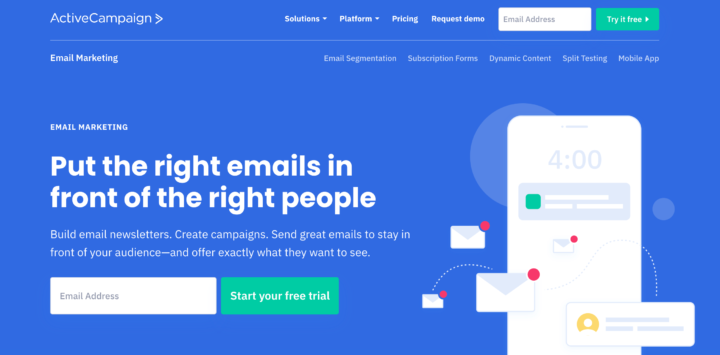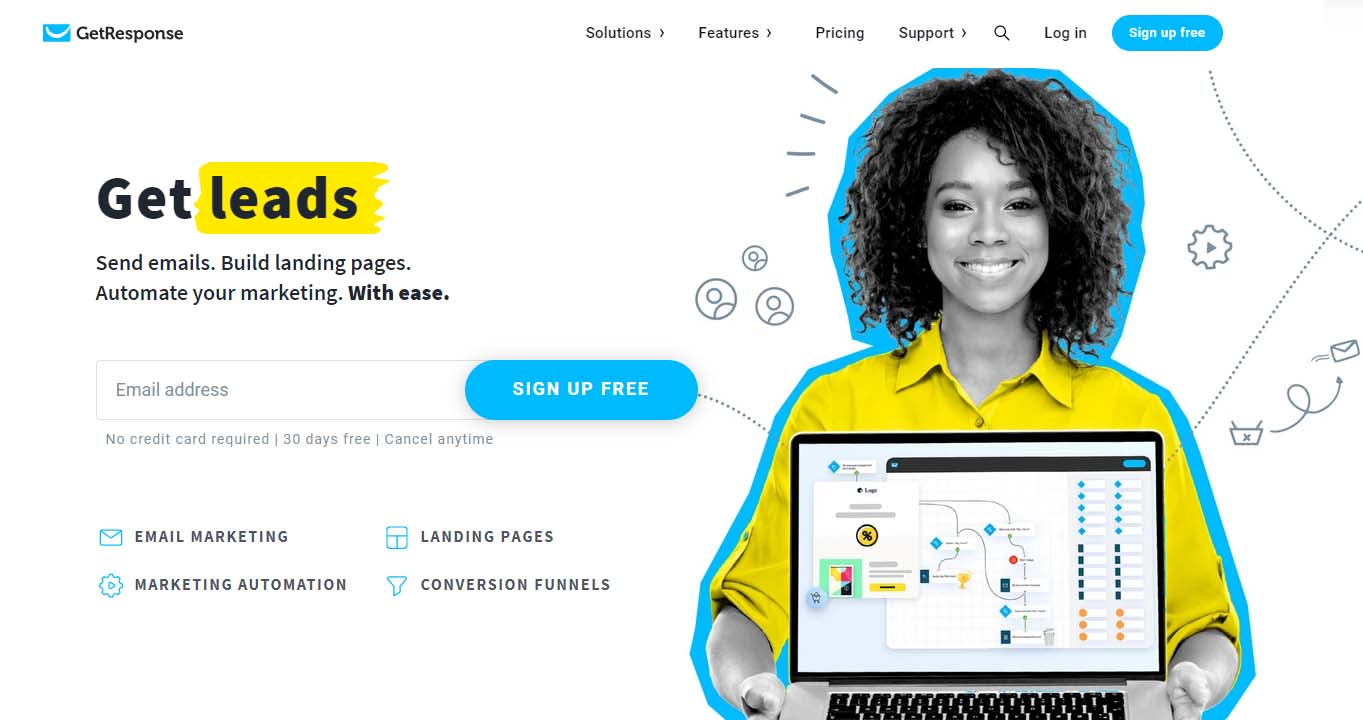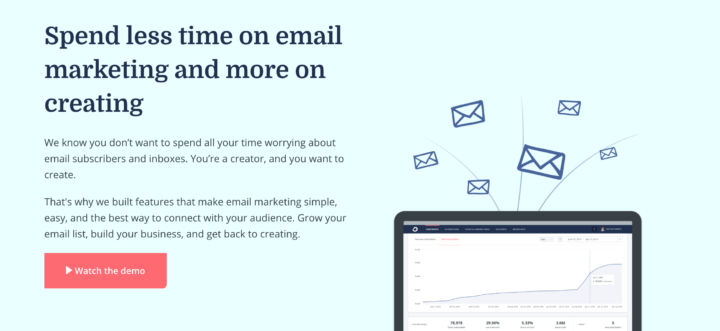When it comes to creating an effective B2B marketing strategy, email is one of the crucial channels that you must not ignore.
In fact, 59% of B2B marketers find email as the most effective channel in terms of revenue generation, and according to HubSpot, email is one of the best sources of B2B leads.
These statistics say a lot about B2B email marketing, isn’t it?
Here are a few more to open your eyes about email as a B2B marketing channel –
- 80% of business professionals believe that email marketing increases customer retention. (HubSpot)
- Clickthrough rates are 47% higher for B2B emails than B2C (WordStream)
- Email marketing generates $44 in revenue for every $1 spent (Campaign Monitor)
- 93% of B2B professionals use email when communicating for business purposes (Hubspot)
- 87% of B2B marketers say email is one of their top free organic distribution channels. (Content Marketing Institute)
Now you must realize the impact you can bring to your business by leveraging Email marketing.
If so, keep reading this article, and I will guide you through different aspects of B2B email marketing and share with you some of the best email marketing practices that you can use to improve your campaign performance.
Ready? Let’s get started.
B2B Vs. B2C Email Marketing: What’s The Difference?
If you have already been doing email marketing for a B2C audience, you must understand that B2B professionals are also “people,” B2B email marketing is quite different.
Here’s how –
1. Long decision-making process
B2B buying decisions are not up to one individual in a company. Even though there’s anyone with such decision-making power, he/she cannot decide without consulting the concerned department.
You have to understand that, unlike B2C, B2B purchases do not affect an individual; they can affect several departments within an organization depending on your products and services.
So, while creating your email marketing strategy, keep this in mind and be prepared for a long life cycle and email sequence to keep your prospects informed and stay on top of their mind when they are ready to make the purchase decision.
2. Logic over Emotion
B2C customers are more likely to respond to emails quicker than B2B professionals. Because of this, B2C emails demand an emotional factor that triggers the recipients’ emotions to make the purchase right away.
However, as I have mentioned in the previous section, the B2B buying process is quite long, and you cannot expect your email recipients to take action instantly based on your email content.
Always remember that B2B decisions are based on information, not emotions. So, for B2B email marketing, your focus should be on providing information about your products and services and how they can solve their problems.
3. Tone of voice
Email content for B2C recipients is usually informal in which you can use humor and emojis to establish friendly relationships with them.
Whereas in B2B, you are sending emails to the decision-makers of your target companies, and it is a good practice to keep the tone of your email content formal. You can surely add some humor, but your focus should be on getting their attention on the critical information about your offerings.
4. Timing
Timing is crucial for successful email marketing campaigns in B2B and B2C industries to get more open rates and click-through-rate(CTR).
Although there’s no right time to send emails in either of the spaces, the best time to send emails can differ because-
- B2B recipients may open their work emails at all times, while consumers might open their personal emails after coming back from work.
- B2B recipients might be busy during working hours, but the same recipients as consumers can be available to check personal email during lunch.
These are just two ideas to give you something to start with. The real game is finding the best time for your customers, and for this, I always recommend analyzing your data before referring to any research data.
How to create a B2B email marketing strategy
Till now, you have seen how email marketing is an effective channel for B2B audiences and how it differs from B2C email marketing.
But, remember that you are not alone trying to make your way into the mailbox of your prospects/customers. So, unless you have a foolproof strategy, your emails will be in the trash the second they drop into a mailbox.
1. Define your target audience
Like any other marketing strategy, you need to define your target audience for email marketing campaigns. You need to answer the following questions –
- Which industries will you be targeting?
- What type of companies will you be targeting?
- Who is going to be your email recipient?
If you have already created ideal customer profiles and identified different customer personas, it will be very easy for you to get the answers to these questions.
If you haven’t defined your ideal customer and buyer personas yet, now will be the perfect time to sit with your team and work on it. For start, you should read this – Step-by-step guide to creating ideal customer profiles for B2B brands
Once, you have identified different types of target audiences, you will get a clear picture of your email recipients. You’ll be able to provide more personalized and relevant content to help them stay updated and make the right decision.
2. Define your goals and KPIs
Like I always say before getting started with any kind of marketing campaign, make sure that you clearly define what you want to achieve from it and how you will measure its performance.
Now, when it comes to setting up goals, you need to ensure that each goal you set is related to your overall marketing and business goals.
If you have already defined the marketing goals for other channels, setting up goals for email marketing shouldn’t be difficult.
However, while setting up your goals, make sure that the goals are specific, measurable, attainable, relevant, and time-bound.
Here are a few examples to show you –
- Get 40% more leads from email in the 3rd quarter
- Get 250 webinar registrations per week
- Improve open rate by 3% this month
- Generate 20% more email subscribers than in July
Being specific with numbers gives you a clear picture of what you are targeting to achieve and can compare the performance from previous campaigns or periods.
Once you have defined your goals, select the metrics that you’ll be tracking to analyze the performance of the email campaigns. These metrics are called Key Performance Indicators or KPIs.
The KPI metrics can vary based on your goals. For example, if your goal is to build brand awareness, you can include the following metrics as KPI –
- Number of subscribers
- Click-through-rate (CTR)
- Open rate
Whereas, if your objective is to generate leads from email campaigns, your KPIs should include metrics like the number of leads, sign-ups, and MQLs.
3. Build your email list
To send emails, you need an email list of your potential customers or prospects (or you can say leads).
So, to build such a list, you have to ensure that there are one or other ways from which people can sign up for your mailing list.
Here are three email-capturing strategies to help you get started –
- Use lead magnets – As you know, business professionals are very much interested in data and if you want to share their contact details, start by offering them reliable and credible resources in exchange.
- Use pop-up forms and bars – Popup forms can be a great way to grant the attention of your website, visitors, to show something they might be interested in.
- Identify your website visitors – Almost 95% of website visitors leave the site without signing up or subscribing to your email list. You can use Leadfeeder which tells you people from which company visited your site. It also shows the email of the potential leads from that company. You can shortlist the most potential list and run a cold email campaign to get them to sign up to your email list in any of the possible ways.
One of the common mistakes that people make while building an email list is buying the list or offering anything just to convert a visitor into a subscriber. It is not good practice for B2B marketing.
In fact, by doing this, you’re just wasting your resources on irrelevant contacts that you may never convert into paid customers. So, for successful email marketing, your focus should be on the quality of contacts in your database, not just on growing the list.
4. Segment your email contacts
Once you have started building your email list, you want to send more relevant and personalized emails based on their behavior on your site.
Remember that every contact in your email list is at a different stage in their buying journey. So, rather than sending a common email to all the contacts, you want your email to be more relevant and personalized to their needs.
You want to provide the right information at the right time to help your prospects make the right decision and when they are ready to make a decision they remember who helped them with relevant information.
So, to make this happen, you first need to segment your audience into different categories –
- Lifecycle stage
- Industry
- Job Title
- File downloaded
- Location
These are just a few ideas that came to the top of my mind right now but you can segment your contacts in any possible way based on the data you collect from subscribers.
5. Create email sequences for each contact segment
By now, you should have created different segments of your email contacts. Now, as discussed in the last step, you want to provide relevant information about your products and services to the subscribers.
The best way to do so is by creating an email sequence for each email segment in such a way that the contacts in your email list learn more about the specific product or services they might want to know about.
For example, if a visitor downloaded a case study on social media marketing for one of the restaurant brands, you can create a series of emails so that the user can learn more about your social media marketing services.
The email sequence for such a user may look like this –
- Email 1: Welcome and Thank you for downloading
- Email 2: Another case study on social media marketing
- Email 3: Why Social Media Marketing?
- Email 4: Explain how your company helps restaurant brands
- Email 5: Tell them why your company is the best
- Email 6: Talk about other marketing services you offer
Similarly, you have to create email content for each of the contact segments and map it to the respective segments.
6. Schedule timing for email delivery
Once you have mapped all the email content to respective segments, you need to set up the time and days when the follow-up emails will be delivered.
After all the hard work you did in making strategy, writing email content, and segmentation, you want your audience to open your email and read it (not just open and archive).
To achieve such a response, you want to send emails in a way that your email recipients don’t feel spammed and unsubscribe from the list. Instead, you want them to find it informative, useful, and relevant to their needs which you have already taken care of in previous sections.
But you have to understand that the timing shapes their feelings about your emails.
If your emails are sent during busy hours, your email is just getting in between their work and may get deleted instantly. However, if the same person receives an email after work, you may receive a better response.
So, while scheduling the emails for B2B professionals, you need to focus on the following factors to get more opens and click-throughs –
- Email frequency (Weekly, bi-weekly, monthly)
- Best days to send promotional emails
- Best days to send newsletters
- Best time to send emails
When your email contacts are business professionals, you need to do your own research to find the best day and time to send emails – you can start with surveying your existing customers or run email campaigns at different times and days for a (or two) month and analyze the result to find your answers.
Remember, for different types of emails you want your recipients to take different actions. So you want to set the timing accordingly.
For marketing promotional emails, you want to send the email when your recipients are most likely free from work and can spend time on your email – interval time or by the end of working hours.
Whereas, if you are sending informative email updates, you want to catch recipients when they prefer to read industry news and updates – early morning or early working hours.
7. Analyze and Optimize
So, you have set up your email campaign with a follow-up automated series, but your work is still not done here.
As always, for the best results from your marketing campaigns, irrespective of channels and platforms, you can’t create and forget it. Instead, you need to keep your eye on the data and optimize it.
Here’s what you should pay attention to when you analyze your email marketing campaigns:
- Open rates – It is the percentage of people who opened your email out of the total number of recipients. This shows the effectiveness of the email subject lines and delivery timing
- Click-through rates – It is the measure of how many people clicked on a hyperlink, CTA, or image within your email. It shows the quality of your email content.
- Unsubscribe rate – It measures how many people unsubscribed from your mailing list. This shows the relevancy of your email content.
Once you have gone through the data and determined the underperforming metrics, you should go ahead and make the changes accordingly.
For instance, if you have observed that the open rate is reasonable, but the click-through rate is very low, you need to improve your email content.
Best B2B Email Marketing Tools
Since you have been reading here, you must be wondering which is the best email marketing tool that you can use to execute the strategy discussed above.
Well, here are the 3 top email marketing and automation tools that I use and recommend to my clients based on their budget and feature requirements –
1. ActiveCampaign

ActiveCampaign is one of the most advanced email marketing and marketing automation tools for B2B marketers. With ActiveCampaign you can automate the journey of a lead from the first touchpoint on your website till they exist in the company ecosystem.
It also offers you a Free Sales CRM to manage contacts, assign deals to team members, and automate the sales sequence. It also provides a drag-and-drop landing page and form builder which you can leverage to build your email list.
Pricing and Plans: ActiveCampaign Lite plan starts at $9/month. However, its plus plan is more relevant for B2B marketing.
2. GetResponse

GetResponse offers a suite of email marketing tools designed to deliver tailor-made offers to your contacts when they’re most active. Without breaking the bank, you can build an effective email marketing strategy in just a few simple steps.
GetResponse also offers you some useful features to add value to your B2B marketing strategy. Features like – Webinar hosting, Conversion funnel creation, and paid Facebook ads can be useful for email list building and nurturing throughout the funnel.
Pricing and Plans: GetResponse pricing starts at $15/month with the Basic plan, but its Plus plan is more suitable and starts at $49/month/1000 contacts.
3. ConvertKit

If you already have a CRM to manage your contacts and are looking for a tool just for email marketing, ConvertKit is the best alternative to ActiveCampaign and GetResponse. You can always integrate ConvertKit with your CRM using Zapier.
Using ConvertKit, you can create landing pages and email forms to capture leads and nurture them by email automation.
Pricing and Plans: ConvertKit starts with a free plan but with email automation and integration access, you can start with $29/month.
Wrapping Up
Whether B2C or B2B, email marketing is a powerful channel for maintaining a conversation with your prospects and customers by engaging them throughout their lifecycle within your ecosystem.
So, now you know how to build an effective email marketing strategy, it is your turn to sit with your team and get started to give a boost to your company’s revenue.
